
Tessa’s Eyes.
When Tessa was born the issue obvious to everyone was that she didn’t have a nose- it was immediately apparent and impossible to miss. It was as plain as the [lack of] nose on her face … It was so unusual … so frighteningly rare in fact, that it dominated everything in her first days. Her daddy and I were heartbroken that our beautiful baby wasn’t ‘perfect’. We were confused about what this actually meant for her and how the doctors would ‘fix’ it. The medical staff were completely consumed with dealing with the issues arising from her single airway and how to keep her breathing unobstructed since newborns automatically breathe through their noses. She was monitored closely for oxygen saturation and intubated, meaning they placed a large tube down her throat and taped it to her face so she couldn’t close her mouth.
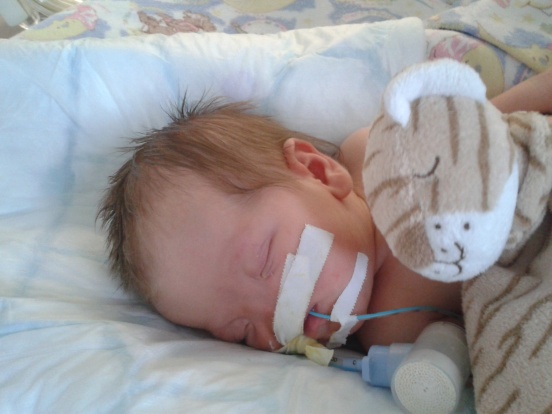
The consultants felt that the best course of action was to give her a tracheostomy tube as a second airway, which would allow her to sleep and eat as normally as possible. We agreed, after much crying on my part, and temporarily moved hospitals for the operation (the Children’s hospital is across the road from the maternity hospital that houses the Neonatal Intensive Care Unit). Here the set-up was completely different and now that we were free from the restrictions of intensive care and I was finally able (actually encouraged) to hold my baby as much as I wished ! Which was ALL of the time 🙂 It felt amazing and because her new tracheostomy meant her face was free from the large tube, I spent every second just gazing at her – exactly the way any mother drinks in her newborn.
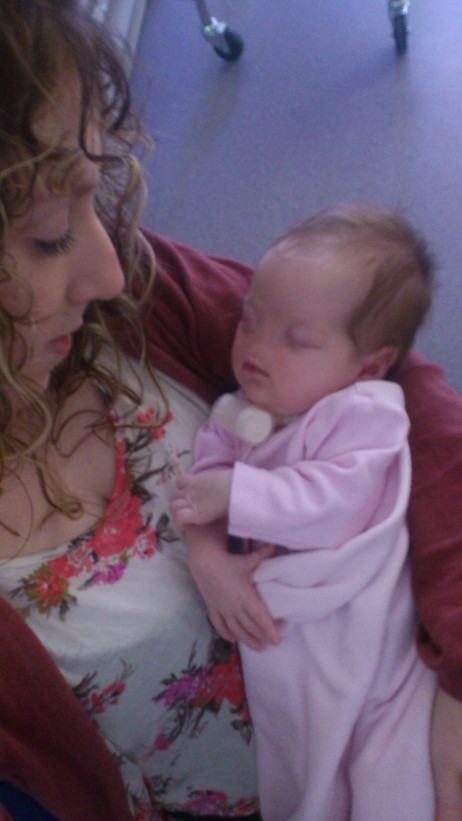
T 3 weeks old.
Over the next couple of days though I would notice that Tessa’s eyes didn’t quite look right and they didn’t look like each other either. Hoping fervently that it was just the light or my imagination, I was reluctant to mention it, especially since she’d been in NICU for 8 days and they had done all kinds of tests and scans. Surely if something was wrong they would have picked it up when they assessed her. But as I sat staring into her eyes late one night I was convinced and called over the doctor. I told him that I thought she was only ‘seeing’ me from her right eye, even though that eye actually looked worse than her left. A 20 second basic eye examination with his torch was enough for him to be able to tell me that her eyes did indeed have several issues, not least of which was a cataract on her left and he would make a referral to pediatric ophthalmology. I tried not to worry too much, still confident she was able to see me at least some of the time. The doctor called for her notes and flicked to her assessment pages where typed under “EYES:” was “NOTHING NOTED”. I was angry since it was clear that no-one had bothered to check her eyes – you only had to look to see they weren’t normal.
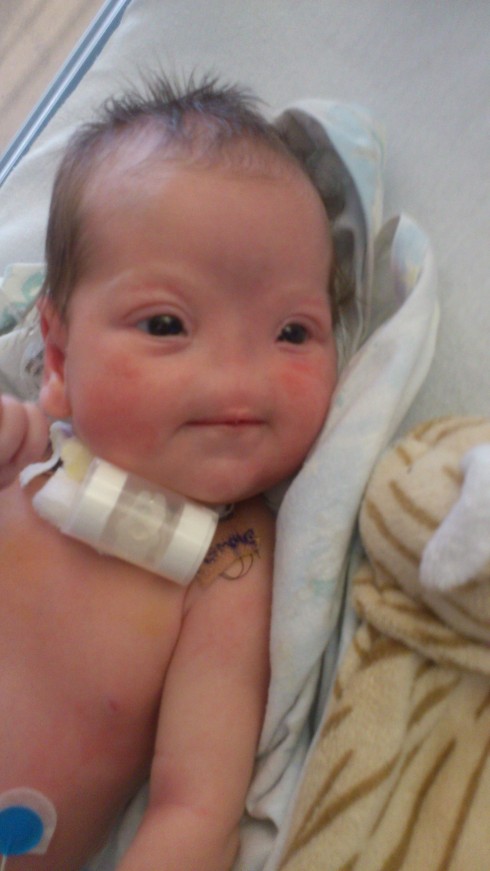
My husband was juggling caring for our two toddlers at home and supporting me at the hospital as much as possible but with a two hour round trip he could only be present so much of the time. We had already had all kinds of specialist appointments like cardiology and ENT etc. and I was still hopeful about her eyes so hadn’t specifically asked Nathan to come up for her eye appointment. It’s something I still regret.
The kindest consultant ophthalmologist in the world, Dr. G, examined Tessa and began to explain what she had found…. it was hard to take it all in. It was so much worse than I had expected. The cataract was so dense she didn’t believe Tessa was able to see anything through it . As if that wasn’t enough the same eye also had extensive coloboma right through the eye (explained to me like a missing piece- like a slice out of a pizza) that affected the retina too and it wasn’t likely that removing the cataract would result in much, if any, vision. Her right eye although much more unusual to look at (the iris had a flattened inner edge and her pupil was off-centre, narrow and hard to see) was the healthier eye. The doctor told me Tessa also has coloboma in that eye but that it only affects the iris which means it shouldn’t affect her vision but her pupil was too small, unusually shaped and ectopic (meaning it isn’t in the middle of her eye). I couldn’t stop crying. It felt so unfair to pile so much on my tiny baby who already had so much to battle . I wished desperately that Nathan or anyone had been with me. It was completely overwhelming just weeks after the shock of her birth to understand and accept such an extensive new list of diagnosis’. And to have to hear it all without a shoulder to cry on was especially difficult.
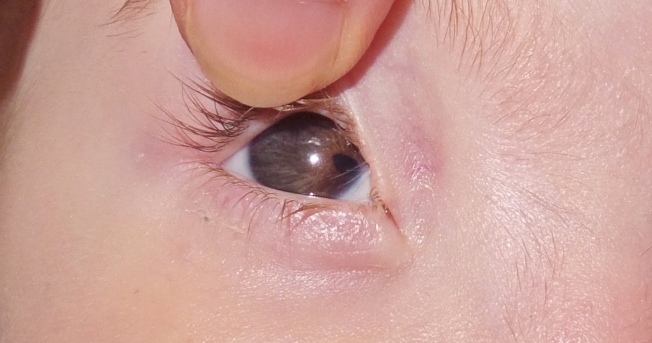
Tessa’s right eye
In order to give Tessa a better field of vision from her tiny pupil she was prescribed dilating drops (the kind you get when you have an eye exam) These enlarged her pupil and needed repeated every four hours or so throughout the day.
When we were finally discharged and settled into life at home, her eye appointments remained frequent. During one such appointment her doctor informed us that she had discussed Tessa’s unusual case with a colleague who suggested that despite the extent of the coloboma in her left eye, there might be a chance Tessa could gain some vision by removing the cataract. This was a huge revelation but there were no guarantees and it would mean another invasive surgery on our tiny baby and a gruelling level of aftercare. We were sent to the Visual Electrophysiology department for tests to see if her brain was picking up signals from that eye. The test process itself was an ordeal as it required sensors to be stuck to her head (which pulled her hair and often needed restuck or repositioned) and lights flashed in her eyes (something she found either uncomfortable or scary) in a dark room (which she definitely found scary).
It was a long and difficult appointment for such a young baby and she needed frequent breaks for nursies and suction but we finally completed the test and the results were very promising. Her brain was picking up signals despite the retinal coloboma behind her cataract! We had a decision to make and precious little time to make it. Tessa was over 10 weeks old and if we agreed they wanted to do the surgery in a matter of days because after 12 weeks the outcomes for this kind of procedure are not as good due to neural pathways being made already.
After much agonising we agreed that if there was a chance we could give her vision in that eye then we owed it to her to try. It was so very difficult to make the decision on her behalf. Surgery was booked for the following week.
At only 11 weeks old Tessa faced her second surgery. The aim was to remove a dense congenital cataract from her left eye to allow for some vision. She looked so tiny in the hospital that morning. She had to fast before her anaesthetic and was confused and upset about why I wouldn’t feed her, it was heartbreaking and, as is often the case, her surgery was delayed ….. I wrapped her in her sling and walked the hospital corridors until she fell asleep and kept walking for the next two hours to ensure she didn’t wake up. Finally her consultant ophthalmologist talked us through the procedure and told us surgery should take about two hours. I held her until she was sedated, then we kissed our baby through the tears and went back to the ward to wait.
It was four hours before we saw the operating consultant again…and she was visibly upset and apologising. Tessa was ok but there had been complications. I was so worried for my baby I could hardly understand what she was saying but she explained that once the operation had started it became clear that Tessa had much more going on in that eye than they had previously thought. The cataract, for one, had actually prolapsed and part was attached to the front of the eye, an extremely rare presentation. Behind it they found that Tessa had an undiagnosed condition known as Persistent Hyperplastic Primary Vitreous or PHPV for short. It meant that her eye was filled with blood vessels that are normally only present while the eye is being formed in the womb. Removing the cataract without rupturing these vessels proved impossible and Tessa suffered bleeding that was difficult to stop. To save the eye most of the inside was removed. She also said that during her career she had operated on a lot of unusually developed eyes but that Tessa’s were the most unusual.
We were in shock. Not only would she never see from that eye, she had almost lost the eye itself and endured a traumatic surgery. It broke my heart and I felt devastated that our hopes had suddenly turned from possible sight to hoping she recovered without major complications. And we still faced months of exhausting, intense, post cataract, eye care. She needed one set of drops hourly, another set every four hours, there was ointment for overnight and cleaning and painkillers. She also had a protective shield to wear over her eye to prevent her scratching or rubbing while the stitches healed. Finding a comfortable way to stick it to her face was a challenge in itself ! It was a gruelling routine and we had all her tracheostomy care to deal with too. Having been prepared for the aftercare as a small price to pay for better vision, it was a bitter pill to swallow to be left with such a workload without the payoff.
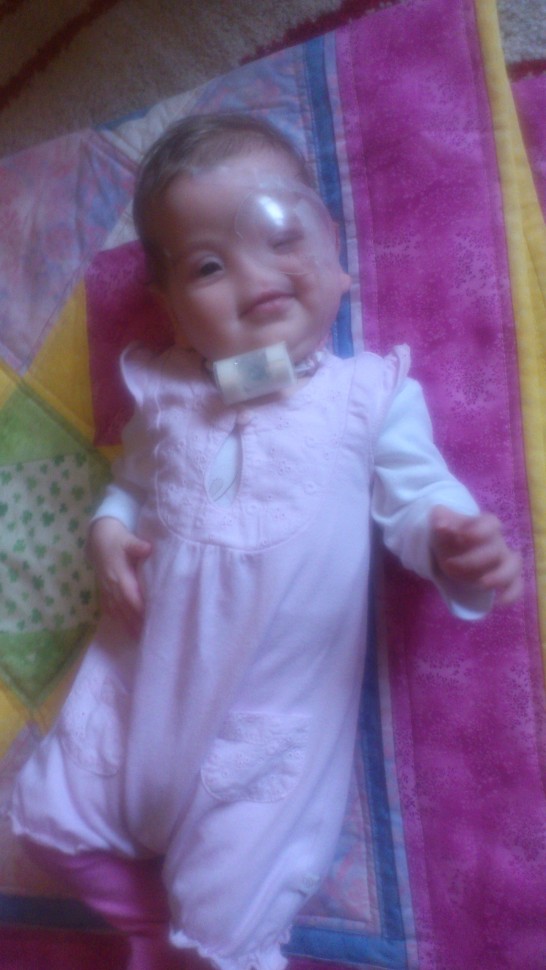
A rare smile due to the numbing drops.
I’m not sure how we managed through those first few months after her cataract operation. I know we were incredibly lucky to have extended family who kept our household running and to whom I will be forever grateful.
We needed to attend the eye clinic twice weekly and even had some unscheduled visits as Tessa was in pain and we weren’t sure what was causing it. She was only happy when the eye was numbed with anaesthetic drops but the effects were short lived and she was only permitted so many doses a day. Her consultant explained that it was likely that the stitches on the surface of her eye were rubbing and causing the pain. We had to wait until they dissolved on their own. I hated seeing her cry her silent cry and feel helpless. It was a very difficult time all round.
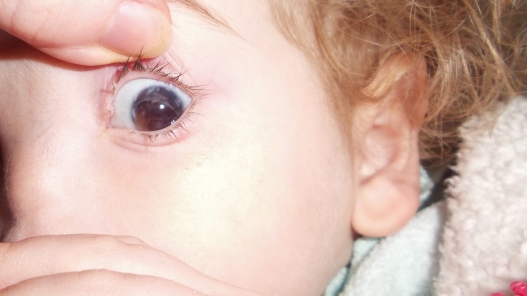
Tessa’s left eye 3 yrs post surgery.
Slowly the routine became more manageable, Tessa’s pain subsided and the appointment frequency lessened. We finally had a little breathing room as a family.
Knowing that Tessa would need to rely on the vision in her right eye meant we were anxious to gauge how well she could see through her narrow, off-centre pupil. We bought special high contrast mobiles and were always looking for clues as to how well she could see the world. Every small, vision related achievement was cause for celebration from grabbing toys accurately to picking fluff off the floor!
The various conditions which affect Tessa’s eyes are all associated with Arhinia and the underdevelopment of her midface. We know of kids with arhinia who have completely unaffected eyes, some who have mild cataracts but good vision and some who have eyes so small and underdeveloped (microphthalmia) that they have little or no vision. A significant proportion of those born with Arhinia are born without eyes at all (anophthalmia).
We are therefore incredibly grateful that Tessa has the vision she has and most people who meet her can’t tell that there is anything wrong with her eyes as she copes extremely well. She no longer uses the dilating drops in her right eye as they were exacerbating her photophobia (light sensitivity) and she couldn’t open her eyes outside at all. She still has trouble on bright days and not having a nose makes wearing sunglasses quite difficult! She does need to hold things very close to her eye to make out detail and doesn’t see well at distance. Her ‘bad’ eye wobbles quite a bit but does still move mostly in sync with her working eye. I have noticed some positional nystagmus (involuntary movement) in her good eye when she looks all the way right but we’ll have to wait and see if this has further implications for her functional vision.

Of course how she sees is normal to her so it can be difficult to tell what she can see clearly and what she compensates for. For example if her brother and sister say they can see the rainbow she says she can too, she will also say the dinner smells nice so we know that she cleverly uses social clues to fill in the things she doesn’t experience.
Because of her cataract surgery Tessa’s left eye has a lifelong risk of developing glaucoma (high pressure in eye) and so she will always have regular eye checks to monitor the pressure in her eyes. So far all her pressure readings have thankfully been within the normal range.
Another issue most aren’t aware of involves her underdeveloped lacrimal ducts (those little holes in the corners of our eyes that drain our tears and excess fluid). Tessa’s eyes water a lot because of inadequate drainage and her eyes often have sticky discharge which can cause infections. It’s common for others with the same problem to experience frequent eye infections and need regular antibiotic eye drops especially during winter months. Amazingly by using breastmilk drops in her eyes at the first sign of trouble, Tessa avoided any infections until she was almost three. My milk dried up due to pregnancy and a few weeks later Tessa developed a horrible conjunctivitis infection which spread causing secondary periorbital cellulitis. It was terrifying seeing how quickly it developed and to feel so helpless. She was admitted on Christmas Eve for IV antibiotics. It was obviously very worrying to have infection in the area where her nasal implant is but thankfully the infection cleared without any complications.
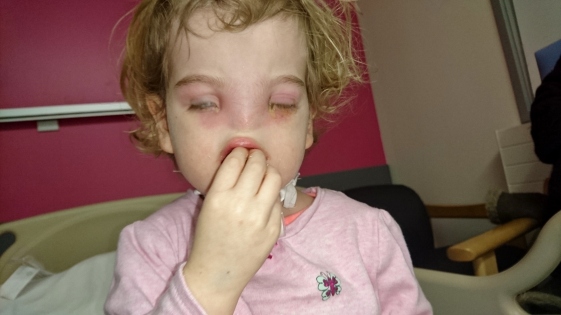
Tessa is due to start pre-school full time in September and as such, how her vision will affect her learning is obviously becoming more important. We are lucky to have the support of several wonderful charities who are an invaluable source of information as we begin the daunting process of ensuring Tessa has adequate and appropriate support at school, both for her trachy and her vision. An assessment by an educational psychologist showed that Tessa was only behind in aspects of development that were purely visual. It is really remarkable given what she’s been through and the fact that if you met Tessa you might never guess that she has eye issues at all … when in fact the rarity and combination of her conditions make her one of the most unusual ophthalmic patients in the world. We’d add one of the cutest too … but then we are unashamedly biased !!

Thank you for following Tessa’s story and we hope this helps explain some of the less obvious challenges she faces because of her condition.